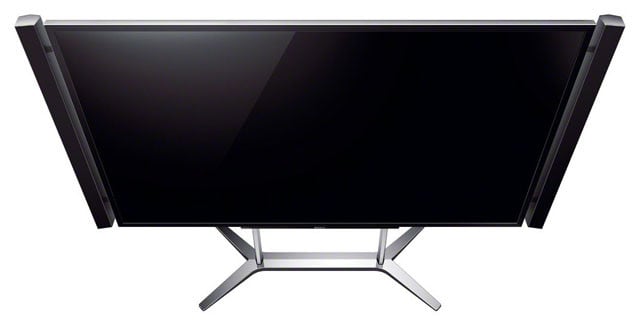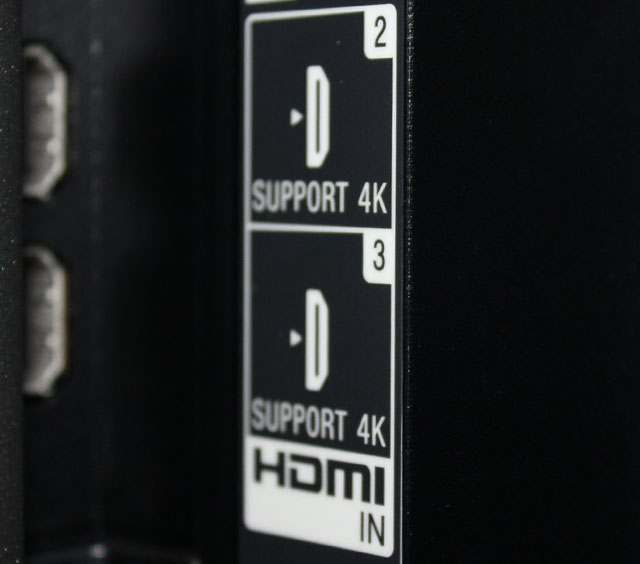Original URL: https://www.theregister.com/2014/01/20/feature_4k_confusion_over_specs_and_standards/
4K-ing hell! Will your shiny new Ultra HD TV actually display HD telly?
Even if it can find content to display, there's no guarantee it'll decode correctly
Posted in Personal Tech, 20th January 2014 12:02 GMT
Feature With just about every TV maker showing off 4K sets at the Consumer Electronics Show (CES) earlier this month, and companies like Netflix promising to have content available in the format, it’s tempting to think that if you’re buying a new TV, 4K may be worth a look. Or, at least, worth hanging on for until it’s more sensibly priced.
It’s also worth looking at recent history too. With the launch of high definition programs on Freeview in the UK, a sizeable number of people discovered that the set they thought they’d bought wasn’t what they actually had bought: an “HD Ready” TV isn't necessarily capable of receiving HD broadcasts.
While Register-reading techies and Digital Europe, the organisation that created the labels, would doubtless say that the definition of “HD Ready” didn’t imply anything about a receiver - there was a separate “HD TV” symbol for that - to many people it was less of a logo and more of a statement that their set was ready for whenever HD broadcasts started.
Unsurprisingly, many of them were a bit miffed to discover that they needed to invest in a separate set-top box to be able to watch Freeview HD broadcasts.
So, are we going to face the same confusion all over again when it comes to 4K TV sets? Will early adopters find that the labels and logos make things more confusing, not less? Are there even going to be any transmissions in 4K, or does a bright new future of internet delivery mean we don’t need to worry about things like compatible tuners any more?
It’s worth noting that even the term 4K isn’t necessarily as well defined as you might think. The Digital Cinema Initiative also has a ‘4K’ standard, set at a resolution of 4096 x 2160 pixels and a 24 frames per second frame-rate. Of course, cinema isn’t quite the same shape as a 16:9 TV image. So when it comes to TV, 4K keeps the square pixels and aspect ratio of current HD standards, and so has a resolution of 3840 x 2160. It’s sometimes referred to as 4K2K, 4KTV or - increasingly by TV manufacturers - as Ultra HD. And down the line, there’s 8K, or Super Hi-Vision, too.
Confused already? Don't worry - the best minds are working on that.
New year resolutions
Back in 2005, Digital Europe was called EICTA (European Information and Communications Technology Industry Association), and launched a certification and labelling scheme allowing sets to carry an “HD Ready” label if they met certain criteria. A separate (but less often seen) “HD TV” label was created for kit that could actually “process and decode” HD transmissions. And then, there were the 1080p variants of those, for the later generations of screens that actually had a full HD resolution.
Technology wasn’t standing still though, and the BBC was leading the effort to create the DVB-T2 transmission standard, which was eventually used for Freeview HD, alongside the H.264 digital video codec. While a sensible choice for transmission, DVB-T2 arguably muddied the waters further. A set could qualify for the HD TV label if it had a DVB-T tuner and MPEG 4 HD decoder, but it still wouldn’t work with the UK’s Freeview HD service.
No wonder so many people were baffled.

And Digital Europe is at it again. In June 2013 it announced that it had started work on a family of labels for 4K, or Ultra High Definition, with the intention that, just like with HD, it will “provide assurance to consumers” who want to purchase new sets.
The baseline capabilities the organisation came up with in September 2013 suggest support for 8-bit colour depth and a frame-rate of up to 60fps, with PCM 2.0 stereo audio. I asked Digital Europe about its views on mandating features like HDMI 2.0, but hadn’t received a response by publication time.
There’s a big problem with all this, though. It’s not content - there’s likely to be a fair bit of that. As was the case with HD, upcoming major sporting events – we have the World Cup this summer – will be used to try and show off the new technology, and Netflix is planning to offer 4K streams. Its second House of Cards series will be among the guinea-pig shows, so there’ll be a fair bit to watch.
Shifting sands
The real problem is more to do with getting the content to you, from wherever it starts out. A 4K stream on Netflix will need a 15Mbps connection, falling back to normal HD at around 11Mpbs, so you’re going to need a pretty decent net connection – and neighbours who aren’t all trying to do the same thing and contend for the overall line bandwidth.
Netflix says it will be using the H.265 codec - aka HEVC - for its 4K service, and has partnered with set makers to ensure that appropriate silicon is included in new sets. That’s in the future, though. Chips to decode H.265 are only just appearing, and so the 4K sets around now don’t have it; you'll have to hang on a few months.
Google’s YouTube, meanwhile, is planning to use the online advertising company’s own VP9 codec, offering the prospect that it will once again hold out against a standard, as it did for a time against H.264. However, it seems unlikely broadcasters and other big content producers will go with Google when they could use the more widely supported H.265.
While IP services will undoubtedly be the way many of us first experience 4K, without a substantial upgrade to the UK’s infrastructure we’re not all going to be watching live UHD video streams any time soon. Without multicast and a lot more bandwidth, it’s not going to be possible for us all to be watching bog-standard HD via the net at the same time, let alone anything of a higher resolution – and that's especially true for those outside major urban centres. And, of course, anyone hoping to deliver lots of streams in 4K will themselves need deep pockets and plenty of bandwidth, too.
If you’re hoping for 4K from Blu-ray, you’ll be waiting a while too. There’s still no defined standard for that, either, though the Blu-ray Disc Association (BDA) anticipates that the details will have been thrashed out by the end of 2014.
So, given there are still questions to answer about delivering content in these ways, how about delivering 4K by traditional broadcast systems?
Airwaves
Broadcast opens up a whole load of other problems, and for many early adopters, the experience with HD was not a happy one, with HD Ready sets lacking the necessary tuners, and even HD TV-labelled kit not necessarily working in the UK.
We could be set for the same dilemmas again. Broadcasters may use H.264 or H.265 - none of them are sure yet. There is, I believe, a chance there may be trials of UHD over terrestrial channels in the UK, just as there were with HD, but it doesn’t necessarily follow that any final service would use the same parameters – remember that the first HD tests on Freeview used DVB-T instead of DVB-T2.
Much may depend on the progress in development of broadcast encoders for H.265. And even if a service were to be launched using H.264, you’d still need the decoder chips in your set to handle the correct profile - H.264 High Profile Level 5.2, since you're asking.
Some readers may be thinking at this point, “Isn’t 4k going to need much more bandwidth than HD?” A 2012 paper presented at the International Broadcasting Conference (IBC), “4K Delivery to the Home”, reckons it needs to shift around eight times as much data for 4K 50Hz progressive scan as for 1080i. At those rates, for the best quality, an existing digital mux or satellite transponder wouldn’t even manage a single channel.
However, all those extra pixels give space to play with, especially when they’re so small you may not even see them. It could be possible to fit two UHD channels in a 45Mbps mux or transponder stream - and that’s using H.264 compression; H.265 is anticipated to do better still - the paper’s author, Pierre Larbier, CTO of French video compression technology firm Ateme, suggested 13Mbps may be sufficient for a 4K broadcast. A live test transmission set up specially for CES by US broadcaster Sinclair used 27Mbps over DVB-T2 to deliver 4K images to the Samsung stand, using the H.265 codec.
Finding space in the spectrum
Of course, with Ofcom keen to squeeze terrestrial TV into ever smaller chunks of spectrum – a cynic might think the addition of extra HD channels are a ruse to persuade more people to buy T2 receivers, ahead of a complete change to that standard – is there any point in even thinking about UHD over the airwaves? Shouldn’t it be left to satellite, cable or IP distribution, for those who want to pay extra for better quality?
On the other hand, what better way to argue for retaining the spectrum than by using it for something that could bring the best quality to far more people, sooner and more efficiently than other delivery methods?

If you think you’ve got a handle on what you need to know before investing in a 4K set, there’s more. Remember that 4K isn’t just about resolution: there’s frame rate too. HDMI 1.4 connectors can support 4K - but only up to 30Hz, which is half what’s proposed by “4K Delivery to the Home”. To manage more than that - and some people think 4K offers opportunities for even higher frame rates - you need HDMI 2.0.
Some of the 4K sets that have shipped already have HDMI 1.4, though Sony for one is promising upgrades. Whether it will deliver is another matter. The HDMI Association says the change “would require hardware and/or firmware upgrades”.
Plugging it in
This month Australian retailer Kogan announced what it claims is the world’s “best value” Ultra HD set, at AU$999 / £550, for a 55-inch set - but despite being a new launch, it too only has HDMI 1.4. Remember too that if you want to run things through an AV receiver, then that’s going to need HDMI 2.0 as well.
Frame rate isn’t all that might improve with Ultra HD, either. 4K offers the chance for increasing colour depth, up from 8 bits per pixel per colour component to ten or 12. In practical terms, that means more accurate rendition of colour, and the depth is one of the decisions that the BDA and others are facing in coming up with their standards or recommendations. If they do opt for increased depth, then September’s “baseline capabilities” from Digital Europe will look a little disappointing.
In short, if you’re thinking of buying 4K right now, be careful. Or, better still, wait. If you think you’d like to take advantage of any terrestrial broadcasts down the line, then you should hang on. Not only will the sets be cheaper, they’ll be more likely to come with both H.264 and H.265 decoders, giving you a better chance of being able to tune in to something.
If you plan to rely on an external source, then make sure that whatever you buy has HDMI 2.0, because if it doesn’t, you’re going to miss out on a lot of content.
And if you’re smart? Wait and see... ®